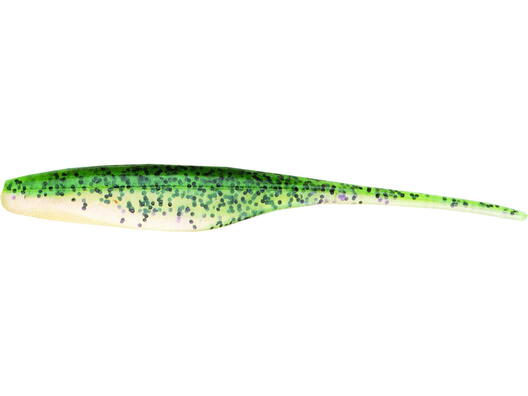Largemouth Bass: Techniques - Soft Jerkbaits
Bass Fishing with Soft Jerkbait

Image Credit: Bass Assassin
Soft jerkbaits are prized by bass anglers for their lifelike action and versatility. Their unique, erratic retrieve mimics injured baitfish, provoking reaction strikes from bass even in challenging conditions. This comprehensive guide covers why soft jerkbaits work, how to select and rig them, effective retrieve techniques, recommended gear, and expert tips from the fishing community.
Why Soft Jerkbaits Work
Soft jerkbaits work by combining a soft, flexible body with an aggressive, stop-and-go action:
- Realistic Movement: Their natural, darting motion simulates a distressed baitfish.
- Versatility in Presentation: They can be fished with a variety of retrieves—from a steady drift to a yo-yo or burn-and-stop method.
- Triggering Reaction Strikes: The erratic action, combined with subtle color flashes, creates visual and vibratory cues that trigger aggressive strikes even when bass are reluctant.
How to Fish Soft Jerkbaits
Retrieve Techniques
Different retrieves can enhance soft jerkbait action:
- Steady Retrieve with Occasional Jerks: Maintain a moderate pace but intersperse short, sharp jerks with pauses to mimic a wounded baitfish.
- Yo-Yo Retrieve: Let the bait sink fully, then reel in slack quickly before letting it drop again. This vertical “yo-yo” action can trigger strikes on lethargic bass.
- Burn & Stop: Retrieve aggressively to “burn” the water, then suddenly stop to let the bait flutter—a presentation that often elicits reaction strikes.
- Variable-Speed Retrieve: Experiment with changing speeds mid-retrieve to create unpredictable movements that bass find irresistible.
Selecting Soft Jerkbaits
Colors, Sizes, and Brands
Your soft jerkbait choice should reflect local forage and water conditions:
- Colors:
- Natural Patterns: Chrome, blue, or silver backs work well in clear water.
- Bright/Fluorescent Options: Chartreuse, yellow, or red are effective in stained or low-light conditions.
- Sizes:
- Smaller Models (2" – 3"): Ideal for finesse presentations when bass are pressured.
- Larger Models (3" – 4"): Better for covering more water and enticing aggressive strikes in deeper water.
- Popular Brands:
- Renowned brands include Bass Assassin, Rapala, Strike King, and Bomber, which are widely favored for their realistic action and durability.
How to Rig Soft Jerkbaits
Correct rigging ensures that the bait’s action remains natural and effective:
- Standard Rig:
- Method: Tie on a treble hook so the hook point is securely embedded in the bait’s head, ensuring a natural, erratic wobble while remaining weedless.
- Best For: Open water fishing with minimal cover.
- Weedless Rig:
- Method: For heavy cover, set the hook deeper into the bait or consider removing the back hook entirely to reduce snag potential.
- Best For: Areas with dense vegetation or near structures.
- Modified (Texpose) Rig:
- Method: Allow a slightly more exposed hook to improve hookset speed during aggressive retrieves.
- Best For: When bass are highly active and aggressive in open water.
Tip: Small changes in hook placement can significantly alter the lure’s action. Experiment to determine the most natural presentation for your conditions.
Recommended Gear
| Gear Component | Recommendation |
|---|---|
| Rod | A fast-action, medium-light rod (6'6" to 7') with a sensitive tip for quick hooksets and detecting subtle strikes. |
| Reel | A reliable spinning or baitcasting reel with a gear ratio above 7:1 for rapid line retrieval during aggressive strikes. |
| Line | Fluorocarbon or braided line in the 10–15 lb test range. Fluorocarbon is ideal for its low visibility in clear water; braid offers durability in heavy cover. |
Community & Expert Tips
- Retrieve Variation: Bass may respond better to a particular retrieve—try steady, stop-and-go, or yo-yo techniques and adjust based on water conditions.
- Match the Local Forage: Select colors and sizes that imitate the baitfish prevalent in your waterway. Natural hues suit clear water, while brighter options are more effective in stained or low-light conditions.
- Rigging Adjustments: Use a weedless rig when fishing heavy cover to minimize snags, and consider a Texpose style in open water for a faster hookset.
- Gear Optimization: A sensitive rod combined with a high-speed reel and appropriate line type can dramatically improve your hookset and overall success.
- Learn from Others: Engage with local bass fishing forums and communities for seasonal and regional tips.
- Practice Makes Perfect: Experiment with different techniques until you develop a presentation that consistently triggers strikes.
YouTube Resource
For a visual demonstration and expert advice on fishing with soft jerkbaits, click the image below to search for "Fishing Soft Jerkbait tips" on YouTube:
Other Popular YouTube Search Terms for Soft Jerkbaits
| Search Term | Link |
|---|---|
| Soft Jerkbait Techniques | |
| Best Soft Jerkbaits for Bass | |
| How to Rig a Soft Jerkbait | |
| Soft Jerkbait Retrieve Tips |
The World's Most Complete Fishing Resource
We're building the ultimate fishing encyclopedia—created by anglers, for anglers. Our articles are created by real experienced fishermen, sometimes using AI-powered research. This helps us try to cover every species, technique, and fishing spot imaginable. While we strive for accuracy, fishing conditions and regulations can change, and some details may become outdated or contain unintentional inaccuracies. AI can sometimes make mistakes with specific details like local access points, parking areas, species distributions, or record sizes.
Spot something off? Whether it's an incorrect boat ramp location, wrong species information, outdated regulations, or any other error, please use the "Help Us Improve This Page" section below. Your local knowledge makes this resource better for every angler.
Explore Related Topics
Discover more articles to deepen your knowledge
Curating articles for you...
Create your own Research Page using AI
Try our AI assistant for free—sign up to access this powerful feature
